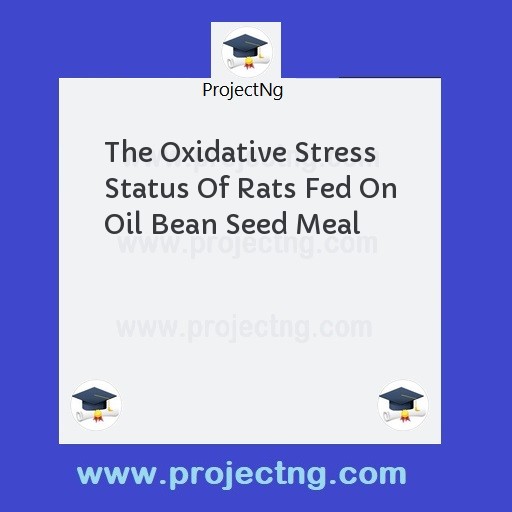The Oxidative Stress Status Of Rats Fed On Oil Bean Seed Meal
Bio-chemistry Project Topics
Get the Complete Project Materials Now! »
ABSTRACT
This study was on oxidative stress status of rat fed with Pentraclethra macrophylla, otherwise known as African oil bean seed oil in English or Ugba in Igbo. Sixteen male rats were distributed into four groups. 1 (control), then group 2, 3, and 4 as test groups. They were fed with their formulated meal (5%, 10%, 20% inclussions) for 28 days. Group 1 was the control and were fed with the normal feed, while group 2, 3 and 4 which were the test groups were fed with test feed formula.. The parameters determined were MDA concentrations and catalase activity. Serum MDA significantly increased (p<0.05) while the catalase activity significantly decreased (p<0.05). This finding may be clinically significant to individuals with predisposition to increased generation of reactive oxygen species (ROS) and other degenerative diseases.
TABLE OF CONTENT
Title page .......................................................................................................... i
Approval page ................................................................................................... ii
6
Dedication ......................................................................................................... iii
Acknowledgment ............................................................................................. iv
Abstract ............................................................................................................ v
Table of content ................................................................................................ vi
Chapter One
1.0 Introduction ................................................................................................ 1
1.1 Aim and objective ...................................................................................... 2
Chapter Two
2.0 Literature Review ........................................................................................ 3
2.1 Classification of oil bean ........................................................................... 5
2.2 Composition of seed .................................................................................. 5
2.3 Fatty acid composition of African oil bean seed ....................................... 6
2.4 Pharmacological uses ................................................................................. 7
2.5 Anti nutrient in health ................................................................................ 9
2.6 Oil bean and humans .................................................................................. 12
2.6.1 Oil bean seed and animals ....................................................................... 14
2.7 Oxidative stress .......................................................................................... 16
2.7.1 Malondialdehyde ..................................................................................... 17
2.8 Catalase ...................................................................................................... 19
7
Chapter Three
3.0 Materials and methods ............................................................................... 21
3.1 Materials ..................................................................................................... 21
3.2 Collection and identification of plant materials ......................................... 21
3.3 Animals ...................................................................................................... 21
3.4 Preparation of oil bean seed meal for animal feeding ............................... 22
3.4 .1 Oil bean seed meal inclusion diet preparations ..................................... 22
3.4.2 Oil extraction ........................................................................................... 22
3.5 Formulation of oil bean seed meal diet ...................................................... 23
3.5.1 Oil bean seed based treatment diet (g/100g Diet) ................................... 23
3.5.2 Chemicals/Biochemicals ......................................................................... 23
3.6 Phytochemical screening ........................................................................... 24
3.6.1 Test for tannins ........................................................................................ 24
3.6.2 Test for alkaloids ..................................................................................... 25
3.6.3 Test for saponin ....................................................................................... 25
3.6.4 Test for flavonoids ................................................................................... 26
3.6.5 Determination of phenols ........................................................................ 27
3.7 Determination of fatty acid composition ................................................... 27
3.7.1 Determination of anthocyanin ................................................................ 28
3.8 Collection of blood sample ....................................................................... 29
8
3.9 Test for malonaldelyde .............................................................................. 29
3.9.1 Catalase assay..........................................................................................30
Chapter Four
4.0 Result and discussion ................................................................................. 32
4.1 Figure i fatty acid composition of extracted oil of pentraclethra macrophylla ........................................................................................................................... 32
4.2 Figure ii malondialdehyde concentration of test and control animal ...... 34
4.3 Figure iii catalase concentration of test and control animals .................... 35
Chapter Five
5.0 Discussion .................................................................................................. 36
5.1 Recommendations ...................................................................................... 38
References ........................................................................................................ 39
CHAPTER ONE
THE OXIDATIVE STRESS STATUS OF RATS FED ON OIL BEAN
SEED MEAL
9
1.0. INTRODUCTION
Ugba also called ukpaka is a popular food delicacy in Nigeria especially among Igbo ethnic group. It is rich in protein and is obtained by a solid state fermentation of the seed of African oil bean tree (Pentaclethra macrophylla Benth).
The natural fermentation of the seed which at present is still done at the house-hold level, renders the production nutritious, palatable and non-toxic (Enujiugha, 2002).
Its production, like many African fermented foods depends, entirely on mixed fermentation by microorganism from diverse source.
Pentaclethra macrophylla Benth is a large woody plant abundant in the rain forest areas of west and central Africa. It’s origin in Nigeria is believed to be around 1937 (Ladipo, 1984); where it is found in the South Nigeria, (Mbajunwa et al., 1998).
―Ugba‖ Pentaclethra macrophylla Benth belongs to the Family Leguminosae and sub-family Microsoideae (Keay, 1989 and NFTA, 1995).
Ugba seeds are irregular and oval; they are flat, black and hard pods. It is composed of oil, protein and small amounts of carbohydrate (Obeta, 1982).
10
1.1 AIM AND OBJECTIVES
(i) To determine the concentration of Malondialdehyde (MDA, which indicates the peroxidation status) and
(ii) The activity of Catalase (a marker of antioxidant status) in the serum of rats fed graded doses of African oil bean seed meal
Be the First to Share On Social

Enjoying our content?
Don't miss out on new videos! Subscribe to our YouTube channel for more awesome content.
Subscribe Now!













